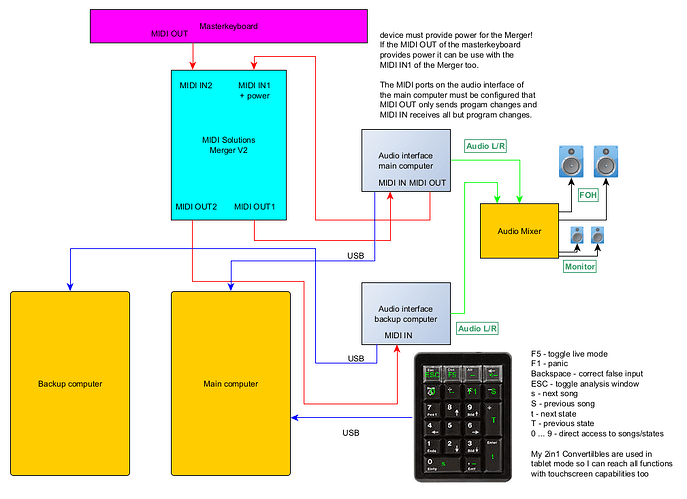Long story short, I need two midi controllers to BOTH talk to TWO computers simultaneously without using Midi 5-pin* cables.
So here’s my situation. I play keys and bass (using amp sims, through the same computer as the keys) live in a working function/dance band. We play somewhere between 75-100 shows a year - almost all one night stands. Setup and teardown same night. Frequently outdoors in the Southern US heat, and in any number of other not-great-for-computers situations (like coastal thunderstorms that frequently come up with little warning). So my computers - despite herculean efforts of maintenance and strict adherence to backup schedules - get banged around and have been known to fail live.
It doesn’t happen often, but it happens often enough that I’ve started having a more traditional “onboard sounds” keyboard (a Numa X 73) on stage - I use it as my second midi controller, but if the computer ever goes down it’s a hot backup.
I would REALLY rather my backup be a second Cantabile Rig. But…the “onboard sounds”/double-as-a-midi-controller keyboard solves one additional problem - it means that one of my midi controller is ALSO triggering my backup rig at all times. It’s triggering itself, obviously. I ALSO use it as my audio engine for Cantabile - so my sound is ALWAYS coming out of that keyboard - it’s just either originating from Cantabile, or originating internally.
So, I could have two midi controllers, both connected to one Cantabile rig, and a second rig powered up with an identical configuration - but in the event of a failure, changing over would mean moving the USB cables from one computer to another, moving the audio cables from one audio interface to another, and then starting the Cantabile engine. That is unacceptably complicated and time consuming for our live show.
[I’m pretty sure with Focusrite audio interfaces, since they have some functionality even if the computer freezes (so long as they maintain power), that I could do a loop where one audio interface’s Out goes to the other one’s In and have a Thru that could be muted until needed - so then I’m always going out of one Interface no matter what, and never have to change audio cables, but I haven’t tested this out yet]
But what I can’t figure out is how to have the midi controller talking to both Cantabile rigs, so that the cantabile rigs could both be actually RUNNING, getting midi signal from both controllers, and continue to do so in the event the main PC crashes. Has anyone done something like this? It seems like a thing other performers would have encountered but I can’t find any information about it.
*I don’t know what the consensus is around here, but I HATE 5 pin midi cables. I’ve found them fragile and unreliable, no matter the brand or cost. I’ve had too many fail on stage, while I’ve had USB cables perform rock-solid for years and years.



